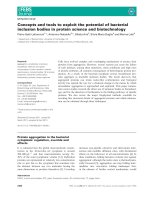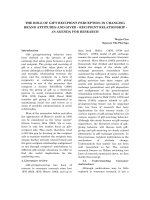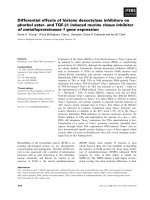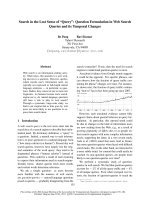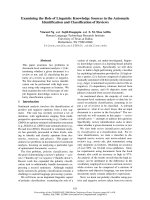Epigenetic potential of histone deacetylase inhibitors in treating fibroproliferative diseases and preventing peri implantational fibrosis
Bạn đang xem bản rút gọn của tài liệu. Xem và tải ngay bản đầy đủ của tài liệu tại đây (17.25 MB, 198 trang )
EPIGENETIC POTENTIAL OF HISTONE DEACETYLASE
INHIBITORS IN TREATING FIBROPROLIFERATIVE
DISEASES AND PREVENTING PERI-IMPLANTATIONAL
FIBROSIS
WANG ZHIBO
NATIONAL UNIVERSITY OF SINGAPORE
2009
EPIGENETIC POTENTIAL OF HISTONE DEACETYLASE
INHIBITORS IN TREATING FIBROPROLIFERATIVE
DISEASES AND PREVENTING PERI-IMPLANTATIONAL
FIBROSIS
WANG ZHIBO
(BDent, MSc)
A THESIS SUBMITTED
FOR THE DEGREE OF DOCTOR OF PHILOSOPHY IN
BIOENGINEERING
DIVISION OF BIOENGINEERING
NATIONAL UNIVERSITY OF SINGAPORE
2009
i
Acknowledgements
I would like to give my sincere thanks to the people who have contributed to and
supported my PhD studies in various ways, in particular:
My supervisor, Associate Professor Michael Raghunath, for his guidance and coaching
on my PhD project. He is very generous with his time and knowledge and assists me in
each step to complete my PhD studies. He teaches me not only how to do experiments,
but also to think as an independent researcher, to share my thoughts with others and enjoy
doing science.
Associate Professor Toan Thang Phan, for providing skin fibroblasts and his suggestions;
Professor Manfred Jung, for providing histone deacetylase inhibitors and his suggestions;
Professor Ian Clark, for providing sequences of primers for MMPs and TIMPs and his
suggestions;
Mr Tan Khim Nyang, for establishing the QICC method together with me during his FYP
in Tissue Modulation Laboratory;
Former and current laboratory members of Tissue Modulation Laboratory, Division of
Bioengineering, for your suggestions and help, including Dr. Ricky Lareu, Dr. Harve
ii
Subramhanya Karthik, Dr. Georgina Salazar, Irma Arsianti, Yin Jing, Lin Gen, Tan Li
Che, Wong Yuan Sy, Felicia Celeste Loe, Clarice Chen, Peng Yanxian, Pradeep Paul
Panengad, Ekarin Chulikorn, Tan Ariel, Benny Paula-Beth Angelica Tiqui, Rafi Rashid,
Anna Maria Blocki, Shayanti Mukherjee, Adeline Sham, Mehta Stuti Girishbhai and Liu
Mei Shan;
Former and current Staff from NUS Tissue Engineering Program, for your assistance,
including Siah Wan Ping, Khoo Hock Hee and To Elaine;
NUS Tissue Engineering Program, for providing the equipments to conduct the study;
My dear father and mother, for your infinite love, understanding and encouragement;
My dear friends, for your valuable friendship and encouragement.
iii
Table of Contents
Acknowledgements i
Table of Contents iii
Summary v
List of Abbreviations viii
List of Tables xi
List of Figures……………………………………………………………………………xii
1. Introduction 1
Part I Literature Review…………………………………………………………… 1
1.1 Fibroproliferative diseases……………………………………………………….1
1.2 Tissue responses to implants…………………………………………………… 9
1.3 Chromatin structure and histone acetylation 20
1.4 HDACs and their roles in regulating gene expression 23
1.5 HDAC inhibitors 26
Part II Purpose & Significance 33
2. Materials & Methods 36
3. Results 46
3.1 Establishment of a microplate reader-based QICC method………………… 46
3.2 Prescreening of the antifibrotic potential of hydroxamate HDAC inhibitors 52
3.3 Characterization of the antifibrotic potential of SAHA on lung fibroblast lines.56
3.4 The antifibrotic potential of SAHA on normal and pathological skin fibroblasts-
a preliminary study 69
iv
4. Discussion 82
4.1 Implementing the PHERAstar microplate reader for quantifying
immunocytochemical signals 82
4.2 Prescreening the antifibrotic effects of three HDAC inhibitors 83
4.3 The antifibrotic effects of SAHA on lung fibroblast lines 85
4.4 The antifibrotic effects of SAHA on skin fibroblasts 87
4.5 HDAC inhibitors interfere with the pro-fibrotic effect of TGFβ1 89
4.6 Inhibitory potential of HDAC inhibitors on the motility of myofibroblasts 91
4.7 The anti-inflammatory property of HDAC inhibitors might be beneficial for
fibroproliferative diseases 92
5. Conclusions 94
6. References 97
Appendices (CV, Publications & Reuse Permissions)
v
Summary
Wound healing is an essential process for the repair of tissue damage after an injury. This
process results in either the regeneration of parenchymal tissue or replacement with
connective tissue (scars). Majority of damaged tissues in adults heal with scars. Normal
scarring is well-regulated. However, pathological scarring, also called fibrosis, is out of
control.
Fibroproliferative diseases involve many organs of the body. The hallmark is the
excessive deposition of collagen, which destroys the original structure and impairs its
function as well. Peri-implantational fibrosis occurs after implantation. It represents the
end stage of a foreign body reaction directed by the host to implants. Peri-implantational
fibrosis, characterized by a collagenous capsule, compromises the performance of
implants and causes implantation failure.
To this day, there is neither effective treatment for fibroproliferative diseases nor
effective prevention of peri-implantational fibrosis. To explore new antifibrotic drugs, we
have been investigating the therapeutic potential of histone deacetylase inhibitors
(HDACis). They are small organic molecules which change gene expression profiles at
the epigenetic level. HDACis are of prime interest in cancer research because they induce
apoptosis in malignant cells. Interestingly, recent work suggested that HDACis might
also inhibit collagen production in fibroblasts. Therefore, we evaluated the antifibrotic
effects of HDACis in vitro.
vi
First, a microplate reader-based quantitative immunocytochemistry (QICC) method using
PHERAstar with a unique focusing lens system was established. Significant higher
signal-to-background ratios in measuring the fluorescence intensities were achieved with
PHERAstar. We further demonstrated that QICC can be used to enumerate cells and
quantify the relative amount of the deposited collagen.
Next, the antifibrotic effects of three hydroxamate HDACis, including trichostatin A
(TSA), M344 and suberoylanilide hydroxamic acid (SAHA), were tested on fetal lung
fibroblasts (FLF) treated with the pro-fibrotic cytokine transforming growth factor β1
(TGFβ1) to induce myofibroblast transdifferentiation. The three HDACis can inhibit
TGFβ1-induced collagen deposition and myofibroblast marker α-smooth muscle actin (α-
SMA) expression non-cytotoxically, while TSA being the most potent.
In the framework of an indication-discovery approach, the effects of SAHA (an FDA-
approved anti-cancer drug) were further characterized on FLF, adult lung fibroblasts
(ALF) and idiopathic pulmonary fibrosis fibroblasts (IPF). SAHA abrogated the pro-
fibrotic effects of TGFβ1 on all the fibroblast lines without inducing apoptosis. Matrix
metalloproteinase 1 (MMP1) activity and tissue inhibitor of MMPs 1 (TIMP1) production,
however, was modulated without a clear fibrolytic effect. SAHA also inhibited serum-
induced fibroblast proliferation. We also found that SAHA reduced TGFβ1-induced
expression of collagen α1(I) (COL1A1), α-SMA, heat shock protein 47 (HSP47) and
connective tissue growth factor (CTGF) at the mRNA level. The mRNA level of MMP1-
vii
2 and TIMP1-4 were regulated by TGFβ1 and SAHA differentially.
The antifibrotic effects of SAHA were also studied on primary normal skin fibroblasts
(NSFs), hypertrophic scar fibroblasts (HSFs) and keloid fibroblasts (KFs). SAHA
inhibited the inducing effects of TGFβ1 on skin fibroblasts. However, higher dose of
SAHA was required in HSFs and KFs than NSFs in inhibiting TGFβ1-induced collagen
deposition.
Taken together, these data demonstrated the antifibrotic properties of HDACis,
suggesting their potential in treating fibroproliferative diseases and preventing peri-
implantational fibrosis.
viii
List of Abbreviations
AF Alexa Fluor
ALF Adult lung fibroblast
APMA 4-aminophenylmercuric acetate
α-SMA α-smooth muscle actin
CBHA Carboxycinnamic acid bis-hydroxamide
cdk Cyclin-dependent kinase
CFSE Carboxyfluorescein succinimidyl ester
ChIP Chromatin immunoprecipitation
COL1A1 Gene for collagen α1(I) chain
CTGF Connective tissue growth factor
DAPI 4,6-diamidino-2-phenylindole
DNMT DNA methyltransferase
ELISA enzyme-linked immunosorbent assay
FGF Fibroblast growth factor
FLF Fetal lung fibroblast
G6PD Glucose 6 phosphate dehydrogenase
HAT Histone acetylasetransferase
HDAC Histone deacetylase
HDACi Histone deacetylase inhibitor
HIF1α Hypoxia-inducible factor 1α
ix
HSF Hypertrophic scar fibroblast
HSP47 Heat shock protein 47
IGF Insulin-like growth factor
IL Interleukin
INFγ Interferon γ
iNOS NO synthase
IPF Idiopathic pulmonary fibrosis
KF Keloid fibroblast
KK Keloid-derived keratinocyte
MBD Methyl-CpG binding domain protein
MCP Monocyte chemotactic protein
MECP2 Methyl-CpG binding protein 2
MEF2 Myocyte enhancer factor 2
MIP-1α Macrophage inflammatory protein 1α
MMP Matrix metalloproteinase
NCOR Nuclear-receptor corepressor
NK Normal human keratinocyte
NSF Normal skin fibroblast
NSIP Nonspecific interstitial pneumonia
NTC Non-template control
OPN Osteopontin
PAI-1 Plasminogen activator inhibitor-1
PBS Phosphate buffered saline
x
PDGF Platelet-derived growth factor
PI Propidium iodide
PVA Polyvinyl alcohol
QICC Quantitative immunocytochemistry
ROS Reactive oxygen species
SAHA Suberoylanilide hydroxamic acid
SCID Severe combined immunodeficiency
SMRT Silencing mediator for retinoid and thyroid hormone receptors
SSc Systemic sclerosis
TGFβ1 Transforming growth factor β1
TGIF 5’-TG-3’-Interacting Factor
TIMP Tissue inhibitor of matrix metalloproteinases
TNFα Tumor necrosis factor α
TSA Trichostatin A
TSP Thrombospondin
TXN Thioredoxin
UIP Usual interstitial pneumonia
VEGF Vascular endothelial growth factor
xi
List of Tables
Table 1 Non-fouling (protein resistant) surfaces…………………………………… 14
Table 2 Primers sequences of the tested genes…………………………………… 44
Table 3 Thermal cycling conditions of q-PCR…………………………………… 45
Table 4 Optical modules and fluorophores used in the QICC system…………… 47
Table 5 Details of normal and pathological skin fibroblasts……………………… 69
xii
List of Figures
Fig. 1 Appearance and histology of keloid………………………………………… 6
Fig. 2 Illustration of the different stages of foreign body reaction………………… 12
Fig. 3 Organization of DNA into chromatin………………………………………… 20
Fig. 4 Biochemical reaction of histone acetylation…………………………………… 22
Fig. 5 Schematic representation of human classical HDACs………………………… 24
Fig. 6 Representative structures of the main classes of known HDAC inhibitors……. 27
Fig. 7 Chemical structure of TSA…………………………………………………… 28
Fig. 8 Structural interaction between TSA and HDAC1-analog HDLP……………… 29
Fig. 9 Principle of the cytotoxicity assay…………………………………………… 41
Fig. 10 Illustration of the setup of QICC system…………………………………… 47
Fig. 11 PHERAstar with the focusing lens improves the signal/background ratio…… 49
Fig. 12 QICC is feasible for cell enumeration……………………………………… 50
Fig. 13 QICC quantifies the deposited collagen……………………………………… 51
Fig. 14 Molecular structures of HDAC inhibitors TSA, M344 and SAHA………… 52
Fig. 15 TSA, M344 and SAHA abrogate the pro-fibrotic effects of TGFβ1…………. 54
Fig. 16 TSA, M344 and SAHA are not cytotoxic…………………………………… 55
Fig. 17 SAHA induces hyperacetylation of histone and α-tubulin…………………… 57
Fig. 18 Dynamics of hyperacetylation of histone 3 and α-tubulin induced by SAHA 58
Fig. 19 SAHA inhibits TGFβ1-induced myofibroblast transdifferentiation………… 60
Fig. 20 SAHA inhibits TGFβ1-induced collagen production………………………… 62
xiii
Fig. 21 SAHA regulates MMP1and TIMP1 differentially…………………………… 63
Fig. 22 SAHA is not pro-apoptotic…………………………………………………… 64
Fig. 23 SAHA inhibits fibroblast proliferation……………………………………… 65
Fig. 24 SAHA modulates the expression of selected genes differentially……………. 68
Fig. 25 SAHA inhibits TGFβ1-induced collagen production in NSFs……………… 72
Fig. 26 SAHA inhibits TGFβ1-induced α-SMA expression in NSFs………………… 73
Fig. 27 SAHA inhibits TGFβ1-induced collagen production in HSFs……………… 76
Fig. 28 SAHA inhibits TGFβ1-induced α-SMA expression in HSFs………………… 77
Fig. 29 SAHA inhibits TGFβ1-induced collagen production in KFs………………… 80
Fig. 30 SAHA inhibits TGFβ1-induced α-SMA expression in KFs………………… 81
1
1. INTRODUCTION
Part I Literature Review
1.1 Fibroproliferative diseases
Fibroproliferative diseases involve many organs of the body, including lung, liver,
cardiovascular systems, eye, kidney, skin. These diseases share some common
pathological features of hyperproliferation of fibroblasts/myofibroblasts, excessive
production and deposition of extracellular matrix and chronic inflammation. The
hallmark of fibroproliferative diseases is the excessive deposition of collagen. Among
this group of diseases, we focus here on idiopathic pulmonary fibrosis and keloid.
1.1.1 Idiopathic pulmonary fibrosis
The interstitial lung diseases constitute a diverse set of lung disorders with different
levels of inflammation and fibrosis resulting in an irreversible loss of lung function and
ultimately respiratory failure. The most common representative of interstitial lung
diseases is idiopathic pulmonary fibrosis (IPF). IPF is defined as “a specific form of
chronic fibrosing interstitial pneumonia of unknown etiology, limited to the lung and
associated with the histological entity of usual interstitial pneumonia (UIP)” (ATS 2002).
The incidence and mortality rate of IPF have significantly increased in the past 15 years.
The incidence rate of IPF has been reported to increase dramatically in the US and UK.
2
Raghu G et al (2006) found that the annual incidence and prevalence of IPF were
estimated to be 6.8 per 100,000 and 14 per 100,000 respectively based on biopsy
procedure or high-resolution computed tomography in the US from 1996 to 2000.
However, with more liberal diagnostic criteria, these figures
rose strikingly to 16.3 per
100,000 and 42.7 per 100,000 respectively. In the UK, the overall incidence rate per
100,000 person-years was 4.6 IPF between 1991 and 2003 with an annual increase of
11%. Crude incidence from 2000 to 2003 was 6.78 per 100, 000 (Gribbin J et al 2006).
Apart from a progressively increased incidence rate, the mortality rate of pulmonary
fibrosis also rose 29.4% (from 49.7 deaths per 1,000,000 in 1992 to 64.3 deaths per
1,000,000 in 2003) in men and 38.1% (from 42.3 deaths per 1,000,000 in 1992 to 58.4
deaths per 1,000,000 in 2003) in women in the US. The total number of decedents were
175, 088 from 1992 to 2003 in the US (Olson AL et al 2007). The increased mortality
rate is partially caused by the fact that IPF affects mostly people 50 to 75 years of age and
patients only have a median lifespan of 2 to 3 years after diagnosis (ATS 2002).
The pathological feature of IPF is still under dispute. Originally, UIP was described as
the unique pathological feature of IPF, which is characterized by the presence of fibrosis
and patchy chronic inflammation, fibroblastic foci and microscopic honeycombing in the
interstitial space of the lung (Liebow AA & Carrington CB 1969). However, this has
been questioned recently as nonspecific interstitial pneumonia (NSIP) was also reported
in IPF biopsies (Flaherty KR et al 2002; Monaghan H et al 2004). It is generally believed
that NSIP shows homogeneous interstitial fibrosis and inflammation, which is distinct
from the heterogeneous pattern of UIP. Nonetheless, the prognosis of IPF seems to be
3
determined by UIP, as IPF patients with UIP-NSIP have similar clinical outcomes as UIP
alone (Monaghan H et al 2004). Currently, it is not clear whether NSIP and UIP belong to
different entities or a spectrum of the same entity.
Therefore, the pathogenesis of IPF has not been fully elucidated yet. This is due to the
limited amount of biopsies from IPF patients and the limitation of current animal models
of pulmonary fibrosis. Currently, there are two different theories. In the 1970s and 1980s,
the inflammation theory was first proposed. It adopts the common principle that
inflammation typically precedes fibrosis in fibroproliferative diseases, and claims that
unremitting inflammation of lung from some unknown injury initiates the repair process
and leads to the final uncontrolled fibrosis in the interstitial space. The inflammatory
theory was established on the observation that the accumulation of macrophages and
neutrophils in the pulmonary alveoli and interstitium of IPF patients (Crystal RG et al
1976, reviewed by Rogliani P et al 2008). In addition, more neutrophils and eosinophils
were detected in the broncho-alveolar lavage fluid from IPF patients than from healthy
controls (Merrill WW & Reynolds HY 1983). Furthermore, proinflammatory cytokines
interleukin (IL)-1 and IL-6, chemokines IL-8, monocytes chemotactic protein 1 (MCP-1),
macrophage inflammatory protein 1α (MIP-1α), Th1 cytokines interferon γ (INFγ), TNFα,
IL-12 and IL-18, and Th2 cytokines IL-4, IL-5, IL-10 and IL-13 are involved in the
pathogenesis of pulmonary fibrosis, yet there are conflicting results on the roles of these
cytokines (reviewed by Gharaee-Kermani M & Phan SH 2005). Based on this theory,
anti-inflammatory drugs like corticosteroids plus immunosuppressive reagents were first
thought to be able to stop the fibrotic process (reviewed by Kim R & Meyer KC 2008).
4
However, many studies have pointed out that the anti-inflammatory regimen appears not
to improve either the typical clinical and high-resolution computed tomography features
of idiopathic UIP (Douglas WW et al 1998) or the survival of IPF patients (Turner-
Warwick M et al 1980; Douglas WW et al 2000). This raised doubts on the initial role of
inflammation in the progression of IPF (Gauldie J 2002; Strieter RM 2002), and led to the
development of the alternative theory which emphasize the initial role of aberrant
epithelial-mesenchymal interactions in IPF. In contrast to the inflammatory theory, it
argues that fibrosis arises as a consequence of chronic epithelial injury and failure of
repair due to aberrant epithelial–mesenchymal interactions in the absence of preceding
chronic inflammation (Nobel PW & Homer RJ 2004).
While the initial factors in the pathogenesis of IPF are still controversial, there is no
doubt on the downstream outcome, i.e. the excessive deposition of a collagen matrix.
Therefore, it is a significant therapeutic goal to control collagen matrix deposition and
turnover by correcting the activated state of IPF fibroblasts/myofibroblasts (Maher TM et
al 2007). Some antifibrotic drugs, such as pirfenidone and IFNγ (Rogliani P et al 2008),
are under clinical trials, their full efficacy is unclear yet. Therefore, there is still an urgent
need for the development of effective antifibrotic drugs. Moreover, it would be promising
to discover new antifibrotic indication of drugs already used in clinical practice for other
diseases since they are already FDA-approved and thus safe and well-tolerated by the
patients (Ghiassi-Nejad Z & Friedman SL 2008).
5
1.1.2 Keloid
1.1.2.1 Histology of keloid
Keloids occur in the process of pathological cutaneous wound healing with excessive scar
formation (Fig. 1a). They seldom regress, and tend to extend beyond the boundary of
original wound with time. The scar does not improve with time. Besides its unattractive
visual effect, it may cause tingling, burning, and itching. Blacks, Hispanics and Asians
are more prone to develop keloids compared with whites. The incidence of keloid varies
from 4.5% to 16% in Black and Hispanic populations (Akoz T et al 2006). The general
causes of keloids include acne, folliculitis, chicken pox, vaccinations, and various kinds
of trauma, such as burns, ear piercing, lacerations and surgical wounds (Robles DT &
Berg D 2007; Juckett G & Hartman-Adams H 2009). Keloids occur on the chest,
shoulders, upper back, back of the neck, earlobes and cheeks most commonly after injury
or inflammation of the skin in predisposed individuals (Bayat A et al 2004; Juckett G &
Hartman-Adams H 2009). Surgical excision combined with auxiliary therapies, such as
steroid injections, silicone sheeting, and compression, are the current treatments for
existing lesions (Slemp AE & Kirschner RE 2006). However, established keloids are
difficult to treat, and they show a high recurrence rate regardless of therapy. Surgical
excision of keloids alone results in a high recurrence rate from 60% to 80% (Kal HB et al
2009), which is believed to even stimulate the formation of an even larger keloid (Brody
GS 1990; Norris JE 1991).
6
The histology of keloid is characterized by nodules of large and thick and hyalinized
collagen fibers (Lee JY et al 2004) (Fig. 1b). The nodules contain dense mass of
fibroblasts and are surrounded by a mucinous extracellular matrix with eosinophils, mast
cells and lymphocytes and numerous microvessels (Blackburn WR & Cosman B 1966).
Contrary to keloids, hypertrophic scars undergo regression after some time and stay
confined to the original wound. Hypertrophic scars exhibit nodular structures composed
of more fibroblastic cells, small vessels, and fine and randomly organized collagen fibers
(Ehrlich HP et al 1994). Less α-smooth muscle actin (α-SMA)-positive fibroblasts are
observed in keloids than hypertrophic scars (Lee JY et al 2004).
Fig. 1 Appearance and histology of keloid. (a) Keloid on the earlobe (Reused with
permission from Wolters Kluwer Health Ltd: Slemp AE, Kirschner RE. Keloids and scars:
a review of keloids and scars, their pathogenesis, risk factors, and management. Curr
Opin Pediatr 2006; 18(4): 397. Copyright @ 2006 Lippincott Williams&Wilkins) (b)
Hyalinized collagen fibers with keloid fibroblasts in between stained with hematoxylin
and eosin (original magnification × 100) (Reused with permission from Lippincott
Williams&Wilkins: Lee JY, Yang CC, Chao SC, Wong TW. Histopathological
differential diagnosis of keloid and hypertrophic scar. Am J Dermatopathol 2004; 26(5):
383. Copyright @ 2004 Lippincott Williams&Wilkins)
1.1.2.2 Pathogenesis of keloid
Although the exact pathogenesis of keloid is still not clearly demonstrated today due to
the complexity of disease, proposed molecular basis of keloid includes an altered growth
7
factor milieu, hypoxia, abnormal epithelial-mesenchymal interactions, altered immune
function and genetic predisposition (Slemp AE & Kirschner RE 2006).
As in other fibroproliferative diseases, the pro-fibrotic cytokine TGFβ is also the central
cytokine in the pathogenesis of keloid and hypertrophic scar (Tuan TL & Nichter LS
1998). The expression of TGFβ1 and TGFβ2 is elevated both at the mRNA (Bock O et al
2005) and protein level (Lee TY et al 1999) in keloids. Keloid fibroblasts are more
responsive to TGFβ1 than normal skin fibroblasts as indicated by a 12 times greater
production of collagen (Younai S et al 1994). DNA synthesis is also accelerated in keloid
fibroblasts (Bettinger DA et al 1996). TGFβ receptors I and II are increased in keloid
fibroblasts (Chin GS et al 2001; Tsujita-Kyutoku M et al 2005). Other growth factors
such as platelet-derived growth factors (PDGF), connective tissue growth factor (CTGF),
insulin-like growth factor (IGF)-1 are also involved in the progression of keloid (Urioste
SS et al 1999).
Apart from TGFβ1, hypoxia may also play a role in the pathogenesis of keloid.
Histological evaluation shows partial to full occlusion of microvessels in keloid due to
excessive proliferation of endothelial cells. This occlusion causes a hypoxic
microenvironment in keloid, and may stimulate excessive production of collagen
(Kischer CW 1992). Elevated level of hypoxia inducible factor 1α (HIF1α) is present in
keloid tissues and keloid fibroblast (Zhang Q et al 2003). HIF1α and its induced VEGF
might promote the excessive accumulation of extracellular matrix from keloid fibroblasts
partially through upregulation of plasminogen activator inhibitor 1 (PAI-1), a potential
8
inhibitor of extracellular matrix breakdown (Zhang Q et al 2004; Wu Y et al 2004).
Moreover, keloid fibroblasts are shown to be more angiogenic compared with normal
skin fibroblasts, which may promote the proliferation of the endothelial cells and worsen
the occlusion of the microvessels and hypoxia. Concentrations of VEGF and TGFβ1 are
significantly increased in culture medium of keloid fibroblasts compared with normal
fibroblasts. Endothelial cells exhibit stronger chemotaxis to conditioned medium from
keloid fibroblasts. Keloid fibroblasts form more angiogenic and larger nodules than
normal fibroblasts in severe combined immunodeficiency (SCID) mice (Masao F et al
2005). In addition, abundant production of VEGF was also detected in the epidermis of
keloids by in situ hybridization (Gira AK et al 2004).
Abnormal epithelial-mesenchymal interaction is also proposed to involve in the
pathogenesis of keloid. This concept was proved in two-chamber co-cultures of
keratinocytes and fibroblasts in vitro. In this system, keloid-derived keratinocytes (KKs)
affect the behavior of normal skin fibroblasts (NSFs) by inducing a faster proliferation
(Lim IJ et al 2001) and secretion of collagen in a keloid-like manner by NSFs (Lim IJ et
al 2002) compared with normal human keratinocytes (NKs). Keloid-derived fibroblasts
(KFs) also induce more secretion of CTGF from KKs into the conditioned media than
NKs (Khoo YT et al 2006). The proliferative response of KKs to IGF is stronger when
co-cultured with KFs than with NSFs. The possible reason may lie in the level of soluble
IGF-binding protein 3 (IGFBP3) from KFs is lower in the paracrine microenvironment
9
compared with NSFs, which might increase the bioavailability of IGF to its receptor and
augment the downstream signaling pathway of IGF-1 in KKs (Phan TT et al 2003).
1.2 Tissue responses to implants
Implantation procedures and the presence of implants initiate a tissue response including
inflammatory and wound healing responses, foreign body reactions and ultimately a
collagenous encapsulation of an implant, be it a biomaterial, a medical device, a
biosensor, a prosthesis, or a tissue-engineered construct.
1.2.1 Biological processes of tissue responses to implants
1.2.1.1 Formation of provisional matrix
Implantation causes injury to the host tissue. The extrinsic and intrinsic coagulation
system, the complement system, the fibrinolytic system, the contact system and platelets
are activated due to the damage of vascular structures. Fibrin is converted from
fibrinogen by thrombin and builds the network of thrombus or blood clot which is formed
on the surface of the implant. Blood proteins deposited on the implant surface represent a
provisional matrix. This matrix mainly includes fibrin and adhesive molecules such as
thrombospondin and fibronectin as well as chemical mediators such as mitogens,
chemoattractants, cytokines, and growth factors released by activated platelets,
inflammatory cells and endothelial cells. The provisional matrix is considered to be a
structural network for cell adhesion and migration as well as sustained factors release
systems to recruit the relevant inflammatory cells (Anderson JM 2001).
10
1.2.1.2 Inflammation reaction
Inflammation, initiated by exudation of serum and its compound and blood cells from the
vascular system, follows the formation of a provisional matrix. Neutrophils infiltrate the
wound in the early and acute stage of inflammation, lasting from minutes to days.
Migration of neutrophils is partially controlled by chemotaxis. It is speculated that
neutrophils mainly release leukocyte products at the surface of implants, instead of
phagocytosis which is the general function of neutrophils in dealing with microorganisms
and foreign materials. The reason lies in the size disparity between the biomaterial
surface and the attached cell (Henson PM 1971). The presence of the implant creates a
constant inflammatory stimulus and leads to chronic inflammation characterized by the
existence of large numbers of macrophages, lymphocytes and plasma cells. It is well-
known that macrophages release a great number of biological active products. Growth
factors such as PDGF, fibroblast growth factor (FGF), and TGFβ are important for the
migration and growth of fibroblasts and endothelial cell in the implant site (Wahl SM et
al 1989). Lysosomal proteinases and reactive oxygen-derived free radicals are potent
mediators in the degradation of biomaterials. Furthermore, macrophages are proposed to
serve as antigen presenting cells in the immune responses against biomaterials (Anderson
JM 2001). Last but not least, shape and chemical and physical properties of the implants
may be also responsible for variations in the intensity and time duration of the
inflammatory and wound healing processes. Thus, each implant may have its own
inflammatory profile.



